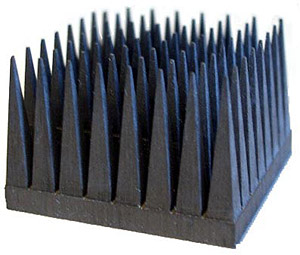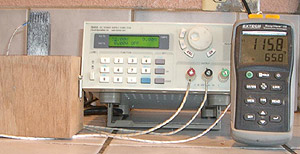
|
|
0%
Abstract: Frostytech departs from the usual pixel fodder for a brief look at some cooling technologies you have never seen before. We touch on some fun tests from the unpublished Frostytech archives and collect all the thermodynamics research we've reported on into one location.
|
Home >
Reviews >
Page: Annex. A) Graphite, Carbon Foam/Fiber, Polymer Heatsinks
|
Annex. A) Graphite, Carbon Foam/Fiber, Polymer Heatsinks
Frequent readers will recognize Frostytech's long time coverage of
non-metallic heatsink materials. Some materials, like diamond, offer
unheard of heatspreading capabilities. Industry focus has been on carbon-based
heatsink materials, whether that be graphite strands, carbon/graphite foam,
carbon nano-fiber, or a metal-graphite matrix.
Here are a few previous news stores that cover a range of non-metallic
heatsink technologies.
Fuzzy Carbon-Fiber Heat Exchangers From FERMILab:
Carbon Fiber is a staple of F1 cars, aircraft, and
low-weight high-strength applications. Carbon also has a nice natural
property that in the right state, it has pretty good thermal conductivity
characteristics. Aluminum sits at 247 W/mK, Copper 398 W/mK, Silver 428
W/mK, and diamond 2000 W/mK. Diamond is an expensive form of carbon for a
heatsink, whereas graphite (25-470 W/mK) and Carbon Fiber (100-520 W/mK)
are much more affordable, very light
weight options.
Researchers at ESLI conducted tests on a small carbon-fiber felt and
tube heat exchanger for FERMILab, to cool silicon chips bonded to its fuzzy
surface (above).
Fluid is pumped via a Neslab chiller through the manifold to test the
responsiveness of the amorphous carbon-fiber tube and felt design, called
"Cooled Fintube Structures."
Carbon Fiber has the benefits of a thermal expansion matching silicon,
high strength to weight, nonpermeability, and high radial heat transfer
according to the researchers. |
|
Anisotropic nano Carbon Fiber heatsinks :
There is a really good presentation on the potentials and
limitations of Anisotropic nano Carbon Fiber heatsinks (thermal
conductivity of 650 W/mK) right here at  Thermocomposite.com The company has developed an
"Oblique Angle Anisotropic Carbon Fiber Heatsink" that looks rather like a
foam tile from an anechoic chamber. The geometry is neccessary because of
the way carbon fibers conduct heat, in order to maximize the cooling
surface area. Thermocomposite.com The company has developed an
"Oblique Angle Anisotropic Carbon Fiber Heatsink" that looks rather like a
foam tile from an anechoic chamber. The geometry is neccessary because of
the way carbon fibers conduct heat, in order to maximize the cooling
surface area. "If using a uni-directional, anisotropic conductive
fiber in a conventional heatsink fin design, you don’t gain the benefit of
the area on the sides of the fins/pins because the heat will only transfer
from the cool side ends of the fibers so its equal to using a non-finned
block of material.

The “patented” oblique angle on at least one end of the fiber
creates a greater surface area for thermal dissipation or transfer to
other fibers. The oblique angle works on both a Micro-(fiber) and a Macro
(structural) level. Even hollow fibers need to be terminated on a oblique
angle pin/fin to maximize surface area of the fiber array exposed to the
cooler environment."
 Thermocomposite Thermocomposite prototype nano conductive carbon fiber
heatsink being tested. |
|
Cooling using Diamond Evaporators, Carbon Foam:
"Carbon foams have been demonstrated to be more efficient
than typical heat sink materials • Power densities up to 100 W/cm2 have
been demonstrated at temperatures less than 100°C"
Evaporative
Cooling Developed By National Security Agency (NSA) in Collaboration
with ORNL.
"Foams will be utilized to replace copper and diamond evaporators and
condensers in thermosyphon Ø Typical diamond evaporators yield ~ 28W/cm2
maximum cooling power at 100°C max temperature"
|
|
Graphite Foam Heat Exchangers and Heatsinks:
A good though old introductory article based on Oak
Ridge National Laboratory research, that discusses the potential
Graphite foam has with respect to heatsinks, and its limitations.
"There are other possible uses for foam heat sinks, as well. They may
prove useful in protecting electronic components on space satellites from
heat damage. Another possible application would be in evaporative cooling,
in which the high specific surface area (>4m2/g) combines with the high
thermal conductivity to produce very efficient cooling as water evaporates
from the foam surfaces." |
|
|
|
1:
Cryo Tech and New Cooling Technologies You Have Never Seen
2:
Thermoacoustic Cooling
3:
Phase Change Waterchilling
4:
Conduction PCB Cooling via Cold Plate Heat Exchangers
5:
The Stirling Cycle Cryo Cooler
6: — Annex. A) Graphite, Carbon Foam/Fiber, Polymer Heatsinks
7:
Annex A) Graphite, Carbon Foam/Fiber, Polymer Heatsinks
8:
Annex B) Diamond, Nano-structure and Metal Foam Heatsinks
9:
Annex B) Diamond, Nano-structure and Metal Foam Heatsinks
10:
Annex C) Heat Exchangers, Microchannel, Capilliary, Spray Watercooling
11:
Annex C) Heat Exchangers, Microchannel, Capilliary, Spray Watercooling
12:
Annex C) Heat Exchangers, Microchannel, Capilliary, Spray Watercooling
13:
Annex D) Computational Fluid Dynamics and Innovative Heatsink Tech
List all FrostyTech heat sinks that Frostytech tested?
|
|
|
|
 |
Websites you may also like:
PCSTATS
|
|
 |


